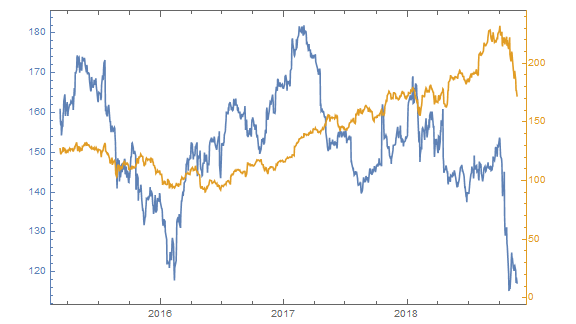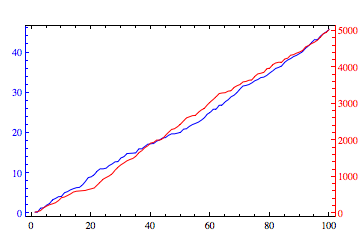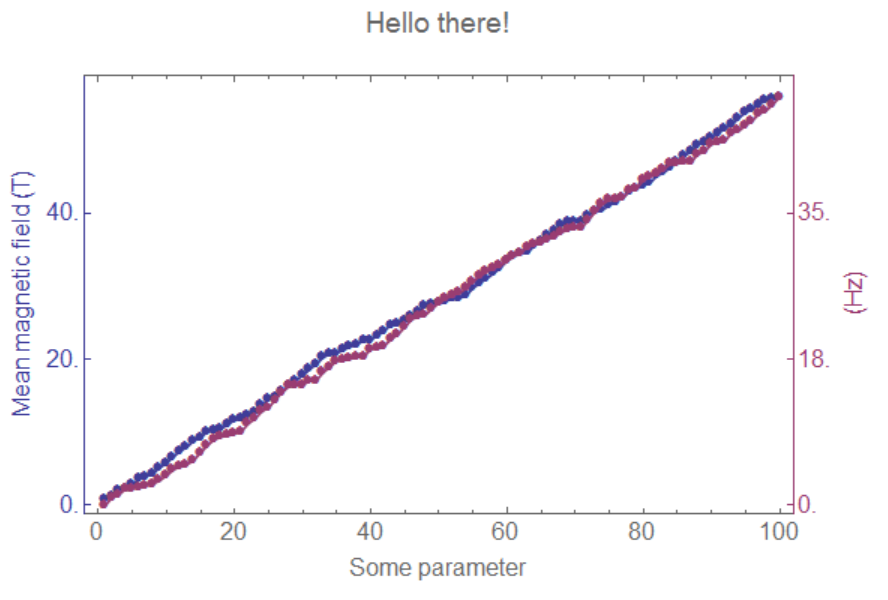By the upper Mr. Jason B.'s nice codes on TwoAxisListPlot, I made one on DateListPlot as TwoAxisDateListPlot as following, some notations listed for helping others to change it to other ***Plot cases.
TwoAxisDateListPlot[{datelistLeft_?ListQ, dateListRight_?ListQ},opts : OptionsPattern[]] :=
Module[ {shapedListRight, plotLeft, plotRight, twoRanges, result},
(*check lists' depth*)
If[ Or[ArrayDepth@datelistLeft != 2, ArrayDepth@dateListRight != 2],
Return[$Failed]
];
(* to be reshaped*)
shapedListRight = dateListRight;
(*find plots'Ranges*)
{plotLeft, plotRight} =
DateListPlot /@ {datelistLeft, shapedListRight};
twoRanges =
Last@Charting`get2DPlotRange@# & /@ {plotLeft, plotRight};
(*reshape dataRight*)
shapedListRight[[;; , 2]] =
Rescale[shapedListRight[[;; , 2]], Last@twoRanges, First@twoRanges];
(*draw together*)
result = DateListPlot[{datelistLeft, shapedListRight},
Frame -> True,
FrameTicks -> {{Automatic,
Charting`FindTicks[First@twoRanges,
Last@twoRanges]}, {Automatic, Automatic}},
FrameStyle -> {{ColorData[97][1], ColorData[97][2]}, {Automatic,
Automatic}}, FilterRules[{opts}, Options[DateListPlot]]];
(*return shaped plots*)
Return[result];
]
TwoAxisDateListPlot[datelistLeft_?ListQ, dateListRight_?ListQ, opts : OptionsPattern[]] := TwoAxisDateListPlot[{datelistLeft, dateListRight}, opts]
simple demos as :
list1 = FinancialData["NYSE:IBM", "March. 8, 2015"];
list2 = FinancialData["NASDAQ:AAPL", "March. 8, 2015"];
TwoAxisDateListPlot[list1, list2]

If some options given, it shows as this.
TwoAxisDateListPlot[list1, list2,
DateTicksFormat -> {"MonthNameShort", ".", "Year"},
FrameLabel -> {{Style["IBM", Larger, Bold],
Style["AAPL", Larger, Bold]}, {None, None}},
PlotLabel -> Style["Stocks Comparsion", 18, Bold]
]

If PlotTheme be used, a new version comes up
TwoAxisDateListPlot[{datelistLeft_?ListQ, dateListRight_?ListQ}, opts : OptionsPattern[]] :=
Module[ {shapedListRight, plotLeft, plotRight, twoRanges, theme, colors, result},
(*check lists' depth*)
If[ Or[ArrayDepth@datelistLeft != 2, ArrayDepth@dateListRight != 2],
Return[$Failed]
];
(*get colors*)
theme = Lookup[Association[opts], PlotTheme, Automatic];
colors =
Most /@ PadRight[{}, {2},
"DefaultPlotStyle" /. (Method /.
Charting`ResolvePlotTheme[theme, DateListPlot])];
(* to be reshaped*)
shapedListRight = dateListRight;
(*find plots'Ranges*)
{plotLeft, plotRight} =
DateListPlot /@ {datelistLeft, shapedListRight};
twoRanges =
Last@Charting`get2DPlotRange@# & /@ {plotLeft, plotRight};
(*reshape dataRight*)
shapedListRight[[;; , 2]] =
Rescale[shapedListRight[[;; , 2]], Last@twoRanges, First@twoRanges];
(*draw together*)
result = DateListPlot[{datelistLeft, shapedListRight},
Frame -> True,
FrameTicks -> {{Automatic,
Charting`FindTicks[First@twoRanges,
Last@twoRanges]}, {Automatic, Automatic}},
FrameStyle -> {colors, {Automatic, Automatic}},
FilterRules[{opts}, Options[DateListPlot]]];
(*return shaped plots*)
Return[result];
]
TwoAxisDateListPlot[datelistLeft_?ListQ, dateListRight_?ListQ, opts : OptionsPattern[]] := TwoAxisDateListPlot[{datelistLeft, dateListRight}, opts]
demos as
TwoAxisDateListPlot[list1, list2,
DateTicksFormat -> {"MonthNameShort", ".", "Year"},
FrameLabel -> {{Style["IBM", Larger, Bold],
Style["AAPL", Larger, Bold]}, {None, None}},
PlotLabel -> Style["Stocks Comparsion", 18, Bold],
PlotTheme -> "Marketing"
]

or
TwoAxisDateListPlot[list1, list2,
DateTicksFormat -> {"MonthNameShort", ".", "Year"},
FrameLabel -> {{Style["IBM", Larger, Bold],
Style["AAPL", Larger, Bold]}, {None, None}},
PlotLabel -> Style["Stocks Comparsion", 18, Bold],
PlotTheme -> "Business"
]

or
TwoAxisDateListPlot[list1, list2,
DateTicksFormat -> {"MonthNameShort", ".", "Year"},
FrameLabel -> {{Style["IBM", Larger, Bold],
Style["AAPL", Larger, Bold]}, {None, None}},
PlotLabel -> Style["Stocks Comparsion", 18, Bold],
PlotTheme -> "Detailed"
]

There's always one for using.




















{fgraph, ggraph} = MapIndexed[ListPlot[#, Axes -> True, Joined -> True, PlotStyle -> ColorData[1][#2[[1]]]] &, {f, g}];. $\endgroup$